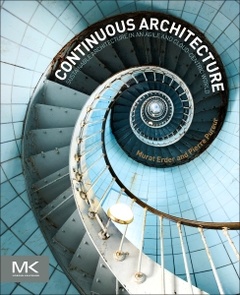Description
Continuous Architecture
Sustainable Architecture in an Agile and Cloud-Centric World
Authors: Erder Murat, Pureur Pierre
Language: English
Subject for Continuous Architecture:
56.19 €
In Print (Delivery period: 14 days).
Add to cartSupport: Print on demand
Description
/li>Contents
/li>Biography
/li>Comment
/li>
Continuous Architecture provides a broad architectural perspective for continuous delivery, and describes a new architectural approach that supports and enables it. As the pace of innovation and software releases increases, IT departments are tasked to deliver value quickly and inexpensively to their business partners. With a focus on getting software into end-users hands faster, the ultimate goal of daily software updates is in sight to allow teams to ensure that they can release every change to the system simply and efficiently. This book presents an architectural approach to support modern application delivery methods and provide a broader architectural perspective, taking architectural concerns into account when deploying agile or continuous delivery approaches. The authors explain how to solve the challenges of implementing continuous delivery at the project and enterprise level, and the impact on IT processes including application testing, software deployment and software architecture.
- A Brief Introduction to Continuous Architecture
- The Principles of Continuous Architecture (CA)
- Getting Started With the Continuous Architecture Process
- Evolving the Architecture
- Continuous Architecture and Continuous Delivery
- Validating the Architecture
- Continuous Architecture in Practice: A Case Study
- How Does Continuous Architecture Impact the Role of the Architect?
- Continuous Architecture in the Enterprise
- What about Enterprise Services?
- Conclusion
Pierre Pureur is Vice President and Chief Enterprise Architect for Travelers. In his role, Pierre leads the Enterprise Architecture group that includes Application Platform Architecture, Information Architecture, Infrastructure Architecture, Performance Architecture and Security Architecture. Prior to his current role, Pierre was the Vice President of Architecture for Personal Insurance Business Technology at Travelers. Prior to joining Travelers, Pierre worked for a number of Financial Services and Consulting Organizations, including KPMG/Bearing Point, Citicorp, Bear Stearns, MetLife, Prudential, EXL, Republic National Bank of New York and People’s United Financial. During his career Pierre’s responsibilities have encompassed all phases of large-scale application development and technology rollout including strategic planning, architecture, design, development and deployment. Pierre has ex
- Covering the application of enterprise and software architecture concepts to the Agile and Continuous Delivery models
- Explains how to create an architecture that can evolve with applications
- Incorporates techniques including refactoring, architectural analysis, testing, and feedback-driven development
- Provides insight into incorporating modern software development when structuring teams and organizations
These books may interest you

Continuous Delivery in Java 61.59 €



